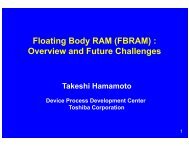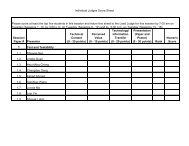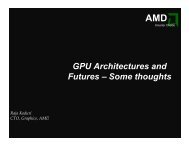The Semiconductor Environment in 1982 - Semiconductor Research ...
The Semiconductor Environment in 1982 - Semiconductor Research ...
The Semiconductor Environment in 1982 - Semiconductor Research ...
You also want an ePaper? Increase the reach of your titles
YUMPU automatically turns print PDFs into web optimized ePapers that Google loves.
SRC: Celebrat<strong>in</strong>g 30 YearsWork<strong>in</strong>g together we are formidable!June 26, 2012
<strong>The</strong> <strong>Semiconductor</strong> <strong>Environment</strong> <strong>in</strong> <strong>1982</strong>U.S. semiconductor companieswere rapidly los<strong>in</strong>g market shareand federal support for siliconresearch was decreas<strong>in</strong>g.Very little silicon-oriented researchwas be<strong>in</strong>g conducted <strong>in</strong> universities.• Less than 100 students and facultyconducted silicon researchAs a result, the pipel<strong>in</strong>e oftalent was dry<strong>in</strong>g up.2
Found<strong>in</strong>g SRC Companies5
Current Found<strong>in</strong>g SRC Member SRC Companies6
SRC Senior Staff (Circa <strong>1982</strong>)Larry SumneyRobert Burger & Richard Alberts7
Example 10-year SRC <strong>Research</strong>Goals (1984) 256Mb DRAM with 0.25 micron m<strong>in</strong>imum featuresize 50 ps logic gate delay and switch<strong>in</strong>g energy of 5 fJ Six person-month design time for error-free layoutof chips with 10 8 transistors Tests that enable less than 1 <strong>in</strong> 10 6 defective devices 5X <strong>in</strong>creased manufactur<strong>in</strong>g productivity10
SRC Goals Were Sometimes Met WithDisbelief• “0.25 micron m<strong>in</strong>imum features – doesn’t that violate the laws ofphysics?”“It is doubtful that one can scale the device dimensions to below 0.1 µm andga<strong>in</strong> any advantage <strong>in</strong> circuit performance because of several basiclimitations“Proc. IEEE (1983): “A systems approach to 1 µm NMOS”NeverHappen!• Work<strong>in</strong>g together, we achieved the 1984 SRC goals!
<strong>1982</strong>: SRC ‘Spr<strong>in</strong>gs <strong>in</strong>to Action’166 proposals received 80 proposals fundedSRC-CMU Center ofExcellence for CADThree research centers were formedSRC-UC/Berkeley Center ofExcellence for CADSRC-Cornell Center of Excellencefor Microscience & TechnologySteve Director, CMUDon Pederson,UC-BerkeleyNoel MacDonald& Jeffrey Frey,Cornell
Knowledge creation for<strong>in</strong>formation technologiesSRC Pathways for CollaborationThis chart represents how SRCimpacts, and is impacted by, itsmember companies. SRC MemberCompanies and Government Partnersdeterm<strong>in</strong>e Industry Needs, provideFund<strong>in</strong>g to Universities, monitor theresearch through regular Reviews andestablish partnerships throughIndustrial Liaisons.SRC Member Companies receive<strong>Research</strong> Results, relevantly educatedand experienced Graduates, access toPublications, Intellectual Propertyand Sp<strong>in</strong>-offs.<strong>The</strong>se outputs benefit thesemiconductor <strong>in</strong>dustry, and Society,as a whole.
SRC Fund<strong>in</strong>g Pathways – Actual $Total Fund<strong>in</strong>gMemberCompanies$955M $190MSRCDirectedFund<strong>in</strong>g• Sources of Directed, Collaborative andInfluenced Fund<strong>in</strong>g are typicallygovernment agencies• Directed Fund<strong>in</strong>g relates toSRC/Agency co-sponsorship of<strong>Research</strong> with all $ managed by SRC∑$1,145M$1,445M$300MCollaborativeFund<strong>in</strong>g• Collaborative Fund<strong>in</strong>g occurs whenSRC and an agency agree to co-fund aresearch programUniversities$455MInfluencedFund<strong>in</strong>g• Influenced Fund<strong>in</strong>g : SRC supportsresearch needs development,proposal evaluations, and l<strong>in</strong>ks fundedprojects to membersOverall: $1.9B
SRC Technical Advisory Boards• Currently there are 1133members of TechnicalAdvisory Boards (TABs)who def<strong>in</strong>e researchneeds/review projects• <strong>The</strong>re have been 1704dist<strong>in</strong>ct TAB membersacross 52 different TABsthroughout the SRC history15
<strong>Research</strong> Reviews• SRC Members take theresponsibility of researchmonitor<strong>in</strong>g very seriously andreview every SRC researchprogram every year• ~ 850 reviews s<strong>in</strong>ce <strong>in</strong>ception to strengthenresearch and the <strong>in</strong>dustry-university partnership
Graduates• S<strong>in</strong>ce <strong>1982</strong>, over 9400 students have workedon SRC sponsored projects.• At any given time, there are between 1200and 1500 students <strong>in</strong>volved <strong>in</strong> SRC research• <strong>The</strong> vast majority of our alumni obta<strong>in</strong>edgraduate degrees, mostly the Ph.D.
Major AccomplishmentsBuilt the world’s largestand most successfuluniversity research forceto support the 10,000-foldadvances of thesemiconductor <strong>in</strong>dustry.• In <strong>1982</strong>, less than 100students and facultyconducted silicon research.3,0002,500No. of Publications24302,00016261,50012471,000500 304 343 34129118001981 1991 2001 2009SRC Member Companies SRC Universities• In 2011, that number is500 faculty and 1,500students!<strong>The</strong> SRC community publishes 20% of theworld’s research on silicon; seven timesmore than AMD, GLOBALFOUNDRIES,IBM, Intel, Freescale, and TI comb<strong>in</strong>ed.18
SRC Influential Publications• Currently, 210 SRC- supported papers havereceived over 100 citations.• Almost 2/3 of SRC’s Influential Publicationshave received at least 15% <strong>in</strong>dustry citations
Celebrat<strong>in</strong>g AccomplishmentsA few examples of research contribut<strong>in</strong>g to ourmembers’ technologies• <strong>The</strong> Copper Revolution• <strong>The</strong> high-K Breakthrough• ‘Green’ Flip-Chip Packages• <strong>The</strong> Birth of CAD Industry
Where Are We Go<strong>in</strong>g?• Some technology projections from currentresearch• Sub-16 nm pattern<strong>in</strong>g• III-V channel FET• Optical Interconnects• 3D-IC• Integrated Sensors• Terahertz Electronics
Many Challenges and Opportunities Stand Before Us• Cont<strong>in</strong>ue to drive-down <strong>in</strong>tegrated circuit fabrication costs• Even as features sizes approach atomic dimensions• Expand the space of <strong>in</strong>tegrated circuit applications• Dramatically reduce energy consumption of <strong>in</strong>tegrated circuits• May need to <strong>in</strong>vent new devices & <strong>in</strong>terconnect technologies• Expand the sensory doma<strong>in</strong> of <strong>in</strong>tegrated circuits• And learn to utilize the vast amount of data that results• Develop new ways of process<strong>in</strong>g <strong>in</strong>formation• Is it possible to develop mach<strong>in</strong>es that reason and discover?
Work<strong>in</strong>g Together We Can AccomplishWonders!“Never doubt that a smallgroup of thoughtful,committed people canchange the world. Indeed,it is the only th<strong>in</strong>g that everhas.”– Margaret Mead
Let’s Keep Roll<strong>in</strong>g!
SRC Pathways for Collaboration







